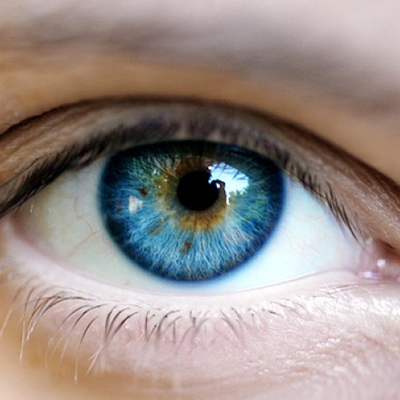Uveitis is an intraocular inflammation of the uvea, the middle layer of the eyeball consisting of the iris, ciliary body and choroid. This pathology represents, in industrialised countries, the fifth most common cause of severe visual impairmentIts complications result in 20% of overall blindness and 35% of uveitis patients, if not treated promptly and correctly, experience blindness or visual impairment in at least one eye.
The patient with uveitis presents symptoms different depending on the anatomical site where the pathology arose:
- Acute anterior uveitis is characterised by photophobia, pain, lacrimation and decreased vision; chronic anterior uveitis may be accompanied by mild redness and myodesopsias (flying flies) or be asymptomatic;
- intermediate uveitis may exhibit myodesopias and may develop into complications such as macular oedema;
- posterior uveitis, may exhibit myodesopias and/or blurring of vision, the latter may worsen leading to decreased vision if the inflammatory process affects the fòvea (central area of the macula responsible for distinct vision).
Although the symptoms seem clear, the diagnosis of uveitis is complicated by the fact that the spectrum of its pathogenesis may involve autoimmunity, neoplasia and pathogens, thus requiring knowledge of internal medicine, infectious diseases, rheumatology and immunology. Laboratory tests are rarely useful as screening tools, the key to diagnosis is therefore a targeted and effective assessment of the patient's history, physical examination of the patient and a thorough review of possible risk factors present.
Risk factors: possible correlation between uveitis and thyroid disease
 Determining the cause of uveitis is not easy, some risk factors However, they increase the likelihood of it being established: juvenile arthritis, psoriasis and other autoimmune disorders, rheumatoid arthritis, inflammatory disorders such as Crohn's disease and ulcerative colitis, HIV and other diseases that weaken the immune system such as brucellosis, herpes simplex, shingles, leptospirosis, Lyme disease, syphilis, toxocariasis, toxoplasmosis and tuberculosis (TB). Furthermore, a correlation has recently been found between thyroid disease and risk of uveitis, hypothesising that the two diseases may share a common autoimmune pathophysiology. Confirmation of a possible correlation between thyroid disease and uveitis also came from the results of another retrospective study published by researchers at Wills Eye Hospital of Thomas Jefferson University in Philadelphia who analysed the medical records of 217,061 patients. The study revealed that the percentage of patients with uveitis who also had an autoimmune disease was definitely greater than in the control groupThis led to the conclusion that autoimmunity is plausibly the mechanism underlying the association between uveitis and thyroid disease.
Determining the cause of uveitis is not easy, some risk factors However, they increase the likelihood of it being established: juvenile arthritis, psoriasis and other autoimmune disorders, rheumatoid arthritis, inflammatory disorders such as Crohn's disease and ulcerative colitis, HIV and other diseases that weaken the immune system such as brucellosis, herpes simplex, shingles, leptospirosis, Lyme disease, syphilis, toxocariasis, toxoplasmosis and tuberculosis (TB). Furthermore, a correlation has recently been found between thyroid disease and risk of uveitis, hypothesising that the two diseases may share a common autoimmune pathophysiology. Confirmation of a possible correlation between thyroid disease and uveitis also came from the results of another retrospective study published by researchers at Wills Eye Hospital of Thomas Jefferson University in Philadelphia who analysed the medical records of 217,061 patients. The study revealed that the percentage of patients with uveitis who also had an autoimmune disease was definitely greater than in the control groupThis led to the conclusion that autoimmunity is plausibly the mechanism underlying the association between uveitis and thyroid disease.
Treatment
Usually, a patient with uveitis who receives timely and appropriate treatment will recover, but lack of timely and appropriate treatment can lead to serious complications such as glaucoma, cataracts, cystoid macular oedema, retinal detachment, permanent loss of vision. The treatment involves, in the presence of an infection, the administration of antibiotics or antiviral drugs, once the infectious risk has been eliminated, medical management traditionally consists of cycloplegic drugs, corticosteroids and, in patients with severe cases that do not respond to steroids or with complications associated with usual therapy, the following may be used immunosuppressants.
These classic therapies are complemented by, new treatments including drugs targeting specific mediators of the immune response such as molecules that block tumour necrosis factor alpha (adalimumab and infliximab), which have been shown to effectively modulate the immune response in patients with uveitis. Adalimumab has been approved in the US by the Food Drug Administration (FDA) for the treatment of non-infectious intermediate uveitis, posterior uveitis and panuveitis in adults and has recently received a favourable opinion from the European Medicines Agency (EMA).
Numerous studies are underway to find new therapies for the future treatment of uveitis without side effects, and in this context a new therapeutic agent, an RNAi (RNA interference acting on gene expression), which when tested on diabetic mice suppressed chronic inflammation in the retina. The study showed that the number of leucocytes in the inflamed vasculature was in fact significantly reduced in the RNAi-treated retina compared to the control retina. The new molecule was also shown to be safe and effective.
Bibliography:
- Garg SJ.Autoimmune thyroid disease and uveitis. JAMA Ophth 2017; DOI: 10.1001/jamaophthalmol.2017.0776.
- Kanda A et al, Molecular Therapy - Nucleic Acids, 2017.
Dr. Carmelo Chines
Direttore responsabile
